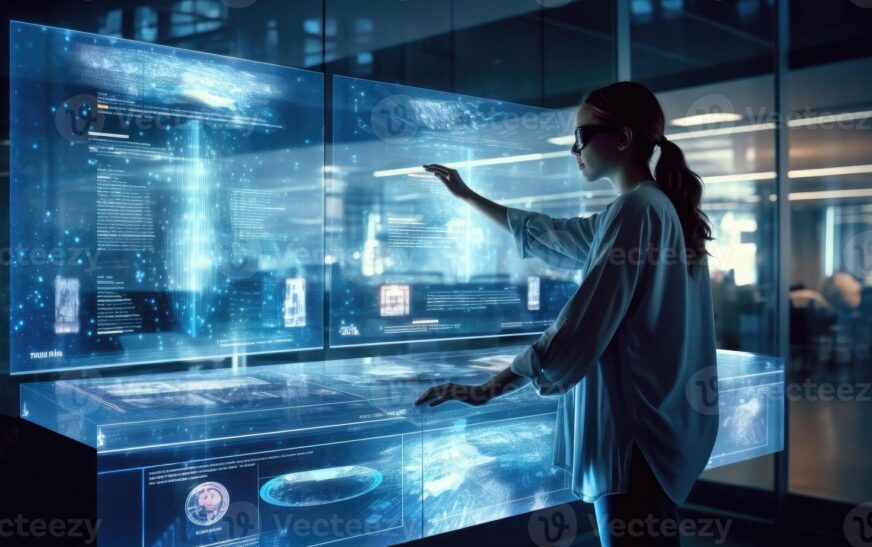Holographic Displays

Introduction to Holographic Displays
Imagine stepping into a world where images leap out at you, dancing in mid-air and captivating your senses.
This is the realm of holographic displays—where technology meets artistry to create breathtaking three-dimensional visuals that transcend traditional screens. Holography has evolved from a niche scientific concept into a game-changing innovation with applications spanning entertainment, education, healthcare, and beyond.
As we delve deeper into this fascinating subject, we’ll uncover the science behind these mesmerizing displays.
You’ll discover how light manipulation creates stunning 3D images and why special glasses may soon become a thing of the past. Join us on this journey through holographic technology as we explore its advantages, challenges, and exciting future potential!

The Science Behind Holographic Technology
Holographic technology relies on the principles of light and diffraction. At its core, it captures and reconstructs light waves to create three-dimensional images.
When laser light hits an object, it reflects off surfaces, scattering in various directions. This reflected light is then recorded onto a medium, such as photographic film or digital sensors. The result is a hologram that holds depth information.
To view these 3D images, special glasses might be necessary in some systems. They manipulate how each eye perceives the light patterns emitted from the display. This unique interaction tricks our brain into interpreting flat images as having volume and space.
Innovative materials are now paving the way for more advanced displays. These materials enhance color accuracy and brightness while reducing distortions often seen in traditional setups. As research progresses, new techniques emerge to refine this captivating visual experience further.

Types of Holographic Displays
Holographic displays come in various forms, each tailored to specific applications and audiences. One prominent type is the holographic projection system. These systems create 3D images by projecting light through diffraction patterns, allowing viewers to see lifelike representations from multiple angles.
Another variation includes volumetric displays. They produce three-dimensional visuals that can be viewed without special glasses. This technology uses rotating screens or other means to generate images suspended in space.
There are also holographic augmented reality (AR) displays, which blend real-world environments with digital elements. Users often wear special glasses for an immersive experience that enhances everyday surroundings with captivating graphics.
There are laser-based holograms widely used in exhibitions and advertising due to their striking visual appeal. Each type offers unique benefits and capabilities, pushing the boundaries of how we perceive information visually.
Advantages of Using Holographic Displays
Holographic displays offer a stunning visual experience that traditional screens simply cannot match. They create lifelike, three-dimensional images that engage viewers on a deeper level.
One of the main advantages is their ability to provide an immersive viewing experience. Users can see depth and perspective from various angles, making presentations and entertainment more captivating.
These displays also enhance interactivity. Gesture recognition combined with holography allows for intuitive navigation through digital content without the need for touchscreens or special devices.
Moreover, they reduce eye strain since light diffuses in a way that resembles natural vision. This means longer viewing times become more comfortable for users.
In addition, holographic technology opens new doors in design and creativity across multiple industries—from advertising to gaming—enabling creators to think outside traditional constraints.

Applications and Future Potential of Holographic Displays
Holographic displays are revolutionizing various industries, pushing the boundaries of how we interact with technology. In healthcare, they offer surgeons a new perspective during complex procedures by visualizing 3D images of organs and tissues from different angles.
Education benefits significantly as well. Holograms can transform traditional learning into an immersive experience, allowing students to engage with subjects like anatomy or astronomy in ways that textbooks simply cannot achieve.
Entertainment is another realm where holographic displays shine brightly. Imagine attending concerts with lifelike performances or enjoying movies where characters leap off the screen, blending seamlessly into your living room.
As advancements continue, possibilities expand further. Smart homes may utilize these displays for interactive interfaces, while retail environments could create captivating shopping experiences through dynamic product demonstrations.
The future promises a world enriched by holography—one where imagination meets reality in stunning clarity and depth.

Challenges and Limitations of Holographic Technology
Holographic technology, despite its impressive capabilities, faces several challenges. One significant hurdle is cost. High-quality holographic displays require advanced materials and intricate manufacturing processes, making them expensive to produce.
Another limitation is the viewing angle. Many holographic displays perform best from specific angles, which can restrict their usability in larger settings or group views.
Resolution also remains a concern. While advancements continue, achieving ultra-high-definition 3D images that remain clear across various distances poses technical difficulties.
Additionally, environmental factors like lighting can impact performance. Bright ambient light may wash out the vividness of projected images.
User accessibility presents issues as well; some applications still necessitate special glasses for optimal experiences. This requirement may deter casual users who prefer convenience over complexity in technology integration.

Conclusion: The Exciting Future of Holographic Displays
Holographic displays are on the brink of revolutionizing how we interact with technology. As innovations continue to emerge, they promise a more immersive experience that transcends traditional screens.
Imagine classrooms where students can manipulate 3D images right in front of them or medical professionals who visualize complex anatomical structures without cumbersome equipment. The potential applications feel limitless.
Advancements in light diffraction techniques will enhance clarity and depth perception, making these displays more accessible in everyday life. From gaming to virtual meetings, experiences will become richer and more engaging.
Research is ongoing, and as we break through current limitations, the dream of glasses-free holography inches closer to reality. This transformation could redefine entertainment and education while opening up new avenues for creativity. The future looks bright for holographic technology; it’s just beginning its journey into mainstream use.
Introduction to Holographic Displays
Holographic displays represent a remarkable leap in visual technology. Unlike traditional screens, these displays create three-dimensional images that seemingly float in space. They do this through the manipulation of light and diffraction patterns, offering an immersive viewing experience.
Imagine watching a lifelike image appear right before your eyes without any special glasses. This captivating effect stems from advanced techniques that capture light fields to produce realistic visuals.
The evolution of holography traces back to the mid-20th century when scientists began exploring how to record and reconstruct light waves. Since then, innovations have transformed these concepts into practical applications across various industries.
Today’s holographic displays are not just about aesthetics; they promise new ways for us to interact with digital content, making experiences more engaging than ever before. The potential they hold is vast and continues to expand as technology progresses.
History of Holographic Technology
Holographic technology has an intriguing history that dates back to the mid-20th century. The journey began in 1947 when Hungarian scientist Dennis Gabor invented holography while trying to improve electron microscopy. His groundbreaking work laid the foundation for creating three-dimensional images through light diffraction.
During the 1960s, advancements surged with the invention of lasers. This pivotal development allowed for more precise and vivid holograms. Researchers like Emmett Leith and Juris Upatnieks expanded on Gabor’s ideas, demonstrating practical applications.
The 1970s saw a surge in interest as artists and scientists experimented with holographic art, captivating audiences worldwide. By the late 20th century, businesses recognized its potential in security features for credit cards and identification documents.
As technology progressed into the digital age, innovations have made holography more accessible than ever before. Today’s developments promise even greater possibilities for displays that can transform how we perceive visuals.

How do Holographic Displays Work?
Holographic displays operate through the manipulation of light to create vivid, three-dimensional images. They utilize a process called diffraction, where light waves bend around an object and project its shape.
At their core, these displays often require special glasses to view the holograms effectively. These glasses filter different wavelengths of light, allowing viewers to perceive depth and dimension in what would otherwise be flat images.
The technology relies on coherent light sources like lasers. These emit beams that interact with physical objects or are digitally generated, producing intricate patterns of interference. This is what makes 3D images appear lifelike.
Digital holography takes things further by using computer algorithms to generate realistic visuals without needing physical models. With advancements in screen technology and optics, the future holds even more promise for immersive experiences through holographic displays.
Advantages of Holographic Displays
Holographic displays offer a visual experience that traditional screens simply can’t match. They create stunning 3D images that seem to float in mid-air, captivating viewers and transforming how we perceive content.
One major advantage is their ability to enhance interactivity. Users can engage with holograms using gestures, making presentations more dynamic and memorable. This engagement can elevate learning experiences across various fields.
Additionally, holographic displays require no special glasses for viewing, which broadens accessibility. Audiences can enjoy the immersive visuals without cumbersome equipment blocking their view.
These displays also provide a greater sense of depth perception. This realism allows artists and designers to showcase their work in innovative ways, enhancing creativity while attracting attention.
Moreover, they are incredibly versatile. Holography finds applications in entertainment, education, healthcare, and marketing—offering endless possibilities for businesses looking to stand out in a competitive market.
Applications of Holographic Displays
Holographic displays are making significant waves across various industries. In healthcare, surgeons can visualize 3D images of organs during procedures, enhancing precision and outcomes.
Education is also benefiting from this technology. Holograms allow students to interact with complex subjects like biology or chemistry in a more engaging way. Imagine studying the human anatomy without needing special glasses to see intricate details!
In marketing, businesses use holographic displays for captivating advertisements that draw customers’ attention instantly. These eye-catching visuals create memorable experiences that traditional media simply can’t match.
Entertainment is another realm where holography shines. Concerts featuring lifelike performances from artists long gone are becoming a reality, providing fans with unique experiences.
Automotive design leverages these displays as well. Engineers can visualize prototypes in real-time, allowing for better collaboration and innovation throughout the design process.
Challenges and Limitations of Holographic Technology
Holographic technology, while fascinating, faces several challenges. One significant hurdle is the cost of production. High-quality holographic displays require advanced materials and complex manufacturing processes. This often makes them less accessible for widespread use.
Another limitation lies in resolution and clarity. Current holographic systems struggle to produce sharp images at larger scales. As a result, viewers may experience distortion when viewed from different angles.
Environmental factors also play a role in performance. Holograms can be affected by ambient light conditions, which can diminish their visual impact.
User experience remains a concern as well. Many existing holographic displays still necessitate special glasses for optimal viewing, complicating usability.
Ongoing research is essential to push the boundaries of this technology further. Innovations must address these limitations before holography becomes commonplace across various industries.

Future Possibilities and Innovations in Holographic Displays
The future of holographic displays is brimming with potential. As technology advances, we can expect even more lifelike 3D images that captivate our senses. Imagine attending a conference where speakers project their holograms into the room, making presentations feel immersive and engaging.
Innovations in light manipulation could lead to displays that don’t require special glasses. This would make the experience accessible for everyone, allowing audiences to interact seamlessly with virtual elements.
Furthermore, integration with augmented reality (AR) may pave the way for hybrid experiences. Users might blend real-world environments with digital enhancements effortlessly.
In sectors like education and healthcare, these displays could transform how information is shared and understood. Medical professionals might visualize complex structures in three dimensions during surgeries or training sessions.
As research continues to evolve, so too will applications across entertainment, gaming, and design industries—unlocking creative possibilities previously thought unimaginable.

Conclusion
The future of holographic displays shines brightly on the horizon. These innovative devices promise to revolutionize how we interact with technology, providing immersive experiences that traditional screens cannot match. As advancements in light diffraction and imaging techniques continue, we can expect even more stunning 3D images without the need for special glasses.
Industries such as medicine, entertainment, and education stand to benefit significantly from this technology. Imagine a surgeon using holograms for precise operations or students exploring intricate biological structures in three dimensions. The potential applications are limitless.
However, challenges remain—like cost and technical limitations—that will need to be addressed before these displays become commonplace. Industry experts are optimistic about overcoming these hurdles through ongoing research and innovation.
As we look forward to further developments in holographic technology, it’s clear that these displays could redefine our visual landscape for years to come. The excitement surrounding their evolution is palpable, encouraging us all to anticipate what lies ahead.






